My grandfather and I shared two connections: food and music. The matzoh ball soup at the restaurant around the corner. Frank Sinatra. Cocoa puffs served with chocolate milk. Glenn Miller Orchestra. Real goulash and occasionally chicken paprikash. Which never, he insisted, never contained tomatoes and was always served over the lightest spaetzle.
Rate this Recipe
5 from 4 votes
Beef Goulash with Einkorn Spaetzle
A traditional, slowly simmered stew of paprika and beef is spiked with caraway seeds and served over heirloom einkorn wheat spaetzle.
Prep Time30 minutes mins
Cook Time2 hours hrs 30 minutes mins
Total Time3 hours hrs
Ingredients
For the Goulash
- 3 tablespoons lard
- 3 yellow onions (chopped fine)
- ¼ cup sweet paprika
- 2 tablespoons caraway seeds
- 2 pounds beef chuck roast
- 1 cup beef bone broth
- 1 tablespoon red wine vinegar
For the Einkorn Spaetzle
- 3 cups all-purpose einkorn flour
- ¼ teaspoon fine sea salt
- 2 eggs
- 1 cup water
- 2 tablespoons salted butter
To Serve
- chopped flat-leaf parsley
Equipment
- Spatzle Press
Instructions
For the Goulash
- Heat the oven to 275 F.
- Melt the lard in a Dutch oven over medium-high heat. Toss in the chopped onion and let it sizzle in the hot fat until it releases its fragrance and turns translucent, about 4 minutes. Turn down the heat to medium-low and continue cooking the onion, stirring from time to time, until the onion browns and begins to caramelize at its edges - about 20 minutes further.
- Stir the paprika and caraway seeds into the onion, and then stir in the cubed beef, stirring constantly to prevent the paprika from burning. Cook the beef in the onions and spices about 4 minutes, then stir in the beef bone broth and vinegar. Cover the pot and transfer it to the oven. Allow it to cook in the oven until the beef is tender, about 2 ½ to 3 hours.
For the Spaetzle
- Dump the flour into a large mixing bowl, stir in the salt. Make a well in the center of the flour, and crack the eggs into the well. Beat the eggs into the flour, and as you beat the eggs, alternately beat in the water and the melted butter. Continue beating the batter until thoroughly mixed, and fine bubbles begin to appear.
- Heat a stock pot full of water to a boil, and then transfer the spaetzle batter to the colander or spaetzle press, and press the batter through into the boiling water. Drain the spaetzle in another colander.
- Melt a few tablespoons addition butter in a cast iron pan. Toss the spaetzle into the hot butter and warm it through.
Finishing the Goulash with Spaetzle
- Remove the goulash from the oven. Plate the spaetzle, and serve the goulash over the spaetzle. Sprinkle it with chopped parsley and serve.

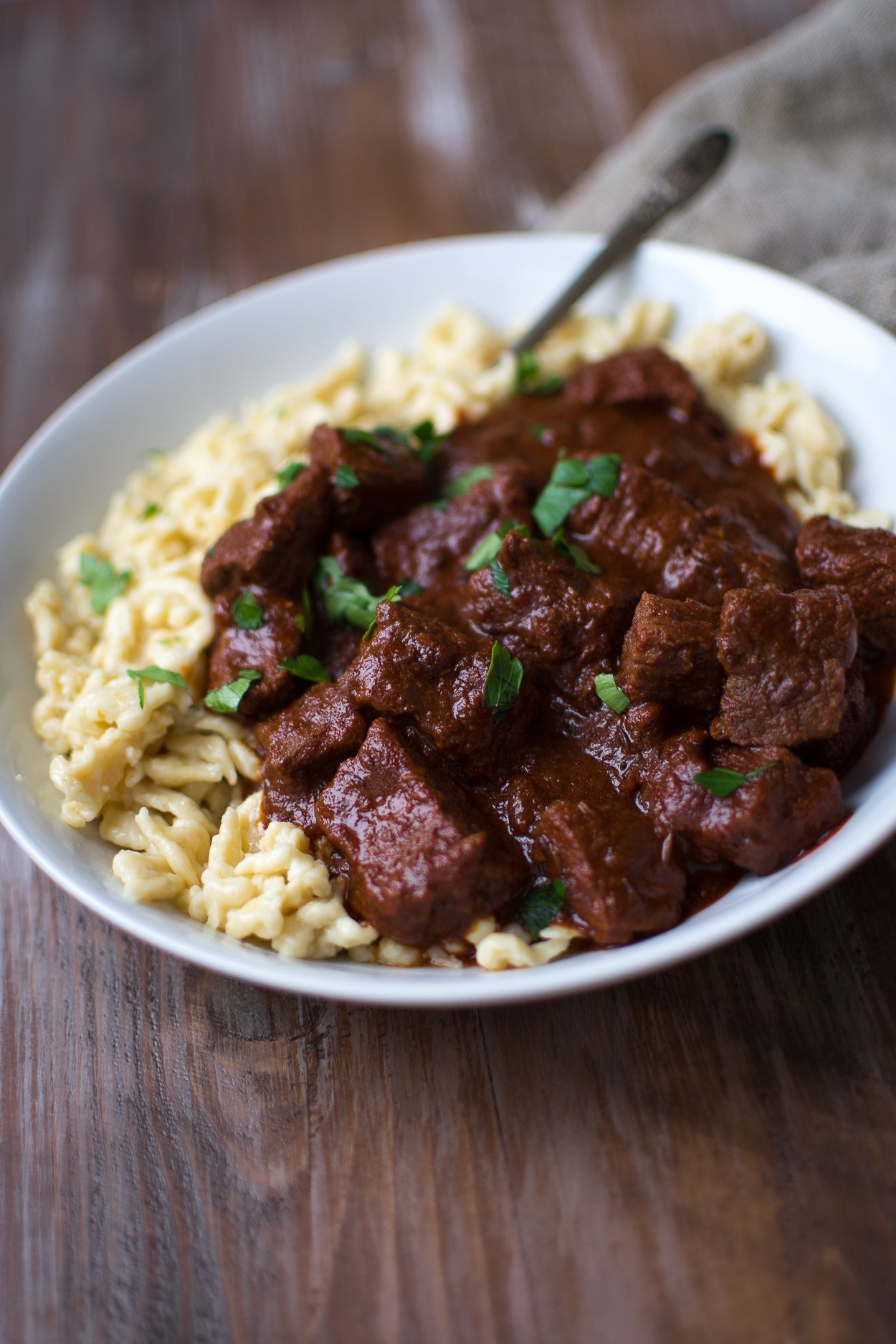
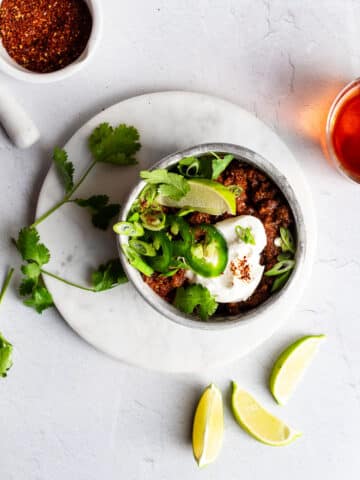
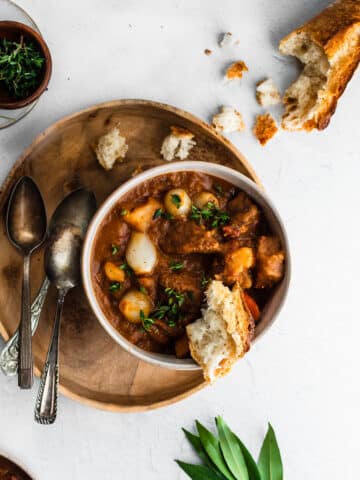
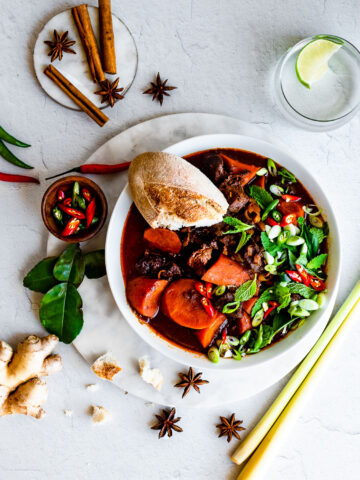
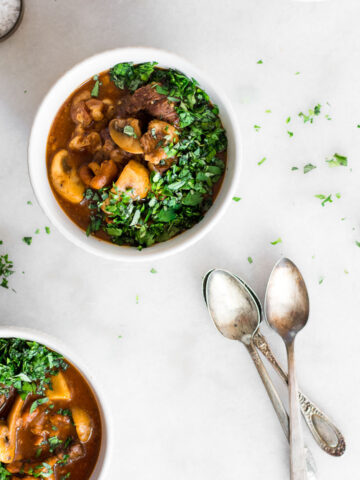
Stephen May says
Excellent recipe! I even impressed my German family! I’m repeating it again today for the 5th time!!
groggery1 says
This is a super and virtually foolproof recipe: just get the quantities right and pop it in the oven. There has been a regular increase in demand for the quantities of chuck steak I am asked to buy. Brings back excellent memories of Vienna and Budapest.
G.
Sarah says
I lived in Germany for a few years, and my host grandma was a fabulous cook. I moved back to the US over a decade ago, and she has since passed away. I never got her recipe for gulasch, and tried making it before with mediocre results. This is by far the closest I have ever gotten to hers, and I’m so excited! I added a bit of heavy cream at the end, like she did, but otherwise mostly followed it. Thank you, this brought me back!
Luann says
Love your recipe and your heart! We keep repeating the same mistakes of history. I hope we figure it out one day.
ds says
A touching and beautiful post.
It is beautiful to address the political / social issues through the lens of one's specialty - be that cooking, writing, dressmaking ...say it with the medium that is close to one's heart.
Mendi says
Thanks a lot for this!
We made it last night and turned out really good!
I read many goulash recipes but this was the simplest and it sure pays out not to over complicate things.
We did do a few variations:
1. We seared the meat before adding to the pot, as I find closing the beef before the long slow cook helps maintain its juiciness.
2. Eating simply cooked dough seems counter-intuitive, and since it was going to be warm in the kitchen for 2.5 hours, we thought might as well make the spaetzle sourdough, so just replaced half of the water with ripe starter, and let the batter ferment while the goulash was in the oven. Also since we don't have a press, just made the batter on the drier side, then (with a bit of flouring) rolled to a long thin snake and cut to tiny chunks with a knife, then in to the boiling water (sort of like gnocchi)
Thanks again! we sure will repeat it this winter!
Deborah says
Wonderful story and legacy!
My grandparents were Hungarian immigrants.
This is actually a traditional Hungarian dish called
Goulash or Gulyas is typically Hungarian as as is the use of quality paprika. The dumplings we call Nokedli. However, it is good to see it is enjoyed by all! ????
Ryan says
Does the Goulash need salt at some point?
Kimberly Dietz says
Jenny;
I'm truly grateful for your story of your grandfather. My Austrian grandmother was brought to America by her parents when she was just a baby. We have had a wonderful life here and though I do not know her story through this context, I imagine that it was also a difficult time. Members of our family, mainly the stadababas spoke Polish, taught us grandchildren how to polka, and hosted the most amazing community gatherings over food and celebration. Gouldsboro, PA is still the home to many of my relatives while my grandparents have passed on.
I am also thankful for your story because right now, at our time of national confusion and trauma, we need stories that help us remember that we are not alone. As well, it is a good reminder, one that I make to my community groups, that this land is not ours. In fact, scientists can show us how all people migrated here.
We are a beautiful melting pot, and your grandfather is likely very proud of you showcasing your family's food heritage as an entree into this needed conversation.
My best,
Kim
Tim Eliason says
Beautiful story and great recipe! Thank you for both. Time for me to buy a spaetzle press
Alethia Helpsmeet says
Thank you so much for this wise and beautiful post, not to mention the delicious sounding recipe.
Liz @ Floating Kitchen says
Thank you so much for sharing your story. I've loved reading everyones posts this week. It's amazing how similar, yet different, the stories are all. I've never made spaetzle, but I love it and always ordered it when we would go to the German restaurant with my Dad and his German relatives. I think I need to try it at home! It doesn't seem that intimidating!
Sophia says
Hi, when at the point in the recipe of cooking the spaetzle in boiling water,there is no indication for doneness. Will the noodles float within a minute or two? I'd like to make this dish in the week ahead. Thanks so much for sharing it.
Jenny says
Hi Sophia,
I'm sorry about that. Spaetzle are done when the dumplings float to the top of the water.
Sophia says
Ok, thanks so much Jenny! I'll report back with how it was (I'm sure delicious!).
Izabella Natrins says
Beautiful story and a lovely recipe Jenny. I too am from a European immigrant family and reading this brought back poigniant memories of my parents' and sister's story. Thank you 🙂
Cheri Reeves says
Thank you so much for this recipe! I am descended from German immigrants and grew up with goulash, but never tasted spaetzle until I moved to Germany to live for a few years. Since returning to the states, I've always bought packaged spaetzle, despite the fact that it doesn't taste quite the same. Can't wait to try this.
Traditional goulash is actually made with a combination of game meats, such as venison, duck or pheasant. I've also had a version using boar! Using beef changes the flavor somewhat, obviously, but my favorite remains a venison only goulash.
Joanne says
Jenny, Whenever I see your email, I can't wait to open it and read your story and the delicious recipe that follows. Tonight, I opened it and found more than your pleasant writings and new recipe. I found a story that stirred my soul. I know that it is just one of so many stories from our country's immigrant's decedents. Most of these stories are heart wrenching tales of decent people leaving what they knew, to come here to what they didn't know. But they came anyway because they just knew that, no matter how hard, it was going to be better than what they were leaving. So many arrived to a reality of something just the opposite but they persevered, kept their dream in their heart and mind and things, for the most part, did get better. So then there were us, the result of all of their hard work, sacrifices and those, all so important dreams. These were strong, brave people and now, so many years later, we celebrate them. That is why these days are so sad for so many of us. There are, and will be, many that won't get this chance. The chance for a better life for themselves and their decedents. Due to our current situations, there won't be decedents here to write stories of sacrifice and hope and of their grandparents, parents, brothers and sisters preserving in this country. Those stories will be lost and because of that, we will all lose.
Aly says
Try living in the Middle East for a few years to view first-hand how Shariah law is in direct opposition to Western law before using your food blog soapbox for insular, less-than-informed diatribes, at such a time as this, about how great it is to welcome one and all to America without perspective or scrutiny. Come Jihadis...Jenny loves you, too. It's ironic how those who want to show how freedom-loving and welcoming they are...saintly as such, do not understand how many in the world view what America has with disdain and an ethos of destruction for the very freedoms we hold so dear. This is more about "Look at virtuous me," than goulash and spaetzle.
DANIEL J.HIGGINS says
JENNY: I HAVE FOLLOWED, USED AND ENJOYED YOUR COOKING LESSONS FOR SEVERAL YEARS ... AND WILL CONTINUE TO DO SO ... HOWEVER ... IF, AND ONLY IF, YOUR OPENING COMMENTS TODAY ARE CONFUSING LEGITIMATE IMMIGRATION WITH THE KNOWN TROUBLEMAKERS IMMIGRATING FROM KNOWN ISLAMIC TERROR SPONSORING COUNTRIES ... COUNTRIES WHERE WE DON'T EVEN HAVE EMBASSIES THROUGH WHICH TO VET THESE WANNABE IMMIGRANTS ... THEN PLEASE STOP YOUR SILLINESS.
AMERICA IS UNDER ASSAULT FROM THE JIHADIES. WE HAVE A RIGHT AND AN OBLIGATION TO PREVENT THEIR DEMONIC BEHAVIOUR IN OUR COUNTRY ... YOU DO REMEMBER SEPT 11 DO YOU NOT? PLEASE ... IF YOU ARE CONFUSING THE LEGITIMATE HOPES AND ASPIRATIONS OF THE REAL IMMIGRANTS WITH THE ILLEGITIMATE DEMONIC INTENTIONS OF THE JIHADIES ... STOP IT!
Jordan says
You are a bad person
Ginger Ackley says
This goulash recipe is absolutely delightful and fascinating! My own family (and cooking) roots lie in Slovenia and Austria, so I was very excited to see a "correct" recipe for goulash! I would LOVE to be able to communicate with someone who knows the old recipes. I have the handwritten recipe journals from my grandmother and her sisters who served in the house of a Baroness back in Innsbruck. The older copies are all in Slovene but I have the journals that my great aunts kept - and that I learned to cook from. I am really committed to not letting this way of cooking fade away.
I've also started a separate project for myself to "reverse engineer" the modern convenience recipes - the ones that called for canned soups - and work out ways of making that comfort food, but with real ingredients. My husband loves my tuna noodle casserole, even though I don't use canned anything! Even the tuna is fresh!
I hope to hear from like minded folks soon! Thanks!
Erica says
Jenny, thank you for sharing the story of your grandfather. My grandparents were also from m Yugoslavia! However they arrived here after World War II with my mother and her sister (2 and 1 years old) in tow
. I have grown up eating Spaetzle. I also grew up eating Goulash, but since my Grandparents lived near the Hungarian border, my grandfather loved Hungarian goulash which was tomato based. I was never a fan. But I am excited to try this recipe!
I am very proud to be the daughter and granddaughter of refugees!
christy lee-engel says
Hi Jenny, this recipe sounds delicious and I look forward to making it, but it's the story of your family that you surround it with that inspires me to comment for the first time in several years of reading your blog. The food of our ancestors, and the recipes and memories and traditions we want to pass to our descendants -- all inextricable from culture and identity and the things we care about most. I find your story, even without the recipe, to be very nourishing in itself. Thank you!
Jessica says
Thank you so much for this delish looking and sounding recipe..., and the message embedded in it. Life is so much richer when everyone has a seat at the table : )
Maddison says
I read (past tense) your blog for healthy recipes and health (key word) related issues- not for your political beliefs. While each person is entitled to their own beliefs, which I both respect and appreciate, a food blog is not the platform for them. After years of reading, I will now be removing your blog from my reader and no longer following.
Lis says
Are you freaking kidding me? Seriously? Your offended by that beautiful story? Wow! Some people...
Candace Boyd says
Beautifully written prose, I can almost smell the onions carmelizing, see the beautiful red red paprika. And spaetzle? Sounds good!
bella says
I love your immigrant food story...I could only imagine how difficult things must have been for your grandfather & his family during that tumultuous time in history. Your words are poignant and so well written: we're, all of us, from somewhere else - and since its beginnings, America was intended to be a place that would allow us to redefine who we are under the promise of freedom. Thank you for sharing & I look forward to making your recipe!
Jill Cooper says
I want to come to your house for dinner!